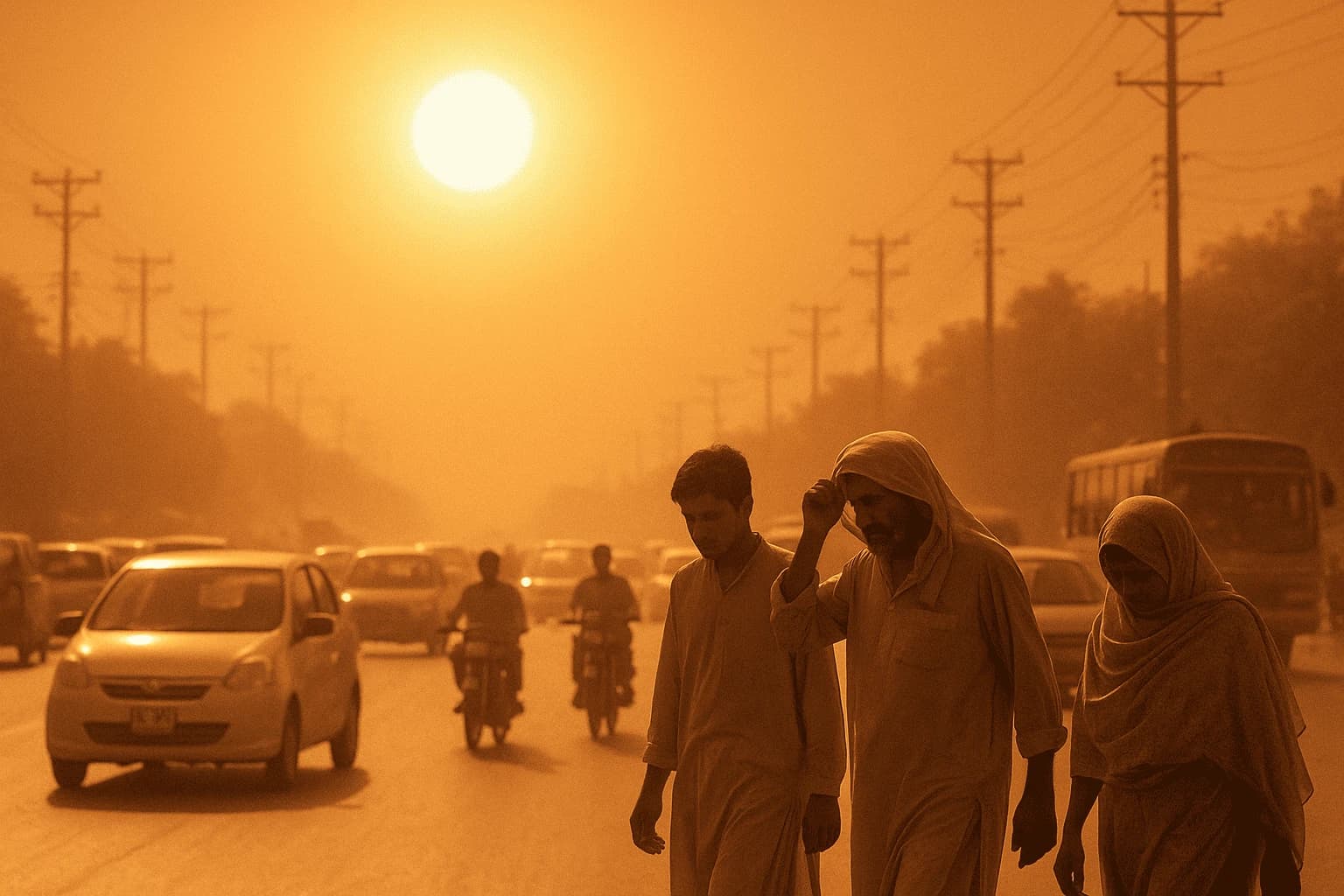© 2025 Roz UpdatesbyTETRA SEVEN

* All product/brand names, logos, and trademarks are property of their respective owners.
The year 2025 has delivered a grim reminder of the growing climate crisis in Pakistan. In April, the country experienced one of its most intense heatwaves on record, with temperatures soaring past 49°C in some areas. From Karachi's sweltering streets to the vulnerable rural communities of Sindh and Balochistan, the heatwave has laid bare the urgent challenges facing Pakistan in a warming world. As global temperatures continue to rise, heatwaves are becoming more frequent and severe, posing grave threats to public health, agriculture, and water resources.
Pakistan is no stranger to extreme weather. However, the ferocity of the 2025 heatwave has taken even seasoned meteorologists by surprise. The Pakistan Meteorological Department (PMD) issued repeated warnings, but the sudden surge in temperature overwhelmed many communities. Hospitals struggled to cope with cases of heatstroke, dehydration, and other heat-related illnesses. Urban centers like Lahore and Islamabad, already burdened by pollution and rapid urbanization, felt the brunt of the urban heat island effect, where concrete and asphalt trap heat and push local temperatures even higher.
At the heart of this crisis lies human-induced climate change. Studies have confirmed that global warming has made such extreme heat events not only more likely but also more intense. The Intergovernmental Panel on Climate Change (IPCC) warns that South Asia will face increasingly severe heatwaves in the coming decades, threatening food security, economic stability, and human lives. In Pakistan, where a significant portion of the population lives below the poverty line, the risks are even more acute.
This blog will delve into the key aspects of the 2025 heatwave crisis in Pakistan. We will explore the record-breaking temperatures, the multifaceted impacts on health and livelihoods, and the critical gaps in policy and preparedness. Most importantly, we will discuss how climate change is fueling this crisis and highlight the urgent need for resilient adaptation measures. By bringing together scientific insights, local perspectives, and policy analysis, this piece aims to spark a conversation about how Pakistan can protect its people and ecosystems in the face of a changing climate.
The heatwave that swept across Pakistan in 2025 was not just another summer scorcher; it was a deadly climate event that laid bare the vulnerabilities in the country’s infrastructure and social systems. This section unpacks the crisis through three critical lenses: the record-breaking temperatures and the regions affected, the socioeconomic and health impacts, and the amplifying role of urban heat islands.
In April 2025, temperatures in Pakistan’s southern provinces of Sindh and Balochistan soared to nearly 50°C, with Jacobabad, often cited as one of the hottest cities on Earth, reaching lethal thresholds. Even in typically moderate regions, like Islamabad, the mercury climbed above 40°C, shattering seasonal records. The PMD’s heatwave alerts painted a grim picture for millions, with agricultural communities and outdoor laborers in rural areas bearing the brunt.
This was not an isolated phenomenon. Across the border, India experienced similar extremes, pointing to a broader South Asian heat crisis driven by climate change. These record temperatures were consistent with projections from climate models that warn of more frequent and severe heatwaves in the region.
The human toll of the 2025 heatwave was devastating. Hospitals reported a sharp increase in heat-related illnesses: heatstroke, dehydration, and cardiovascular emergencies. Informal settlements in major cities like Karachi and Lahore, where housing is often poorly ventilated and lacks access to reliable water, saw significant casualties.
Beyond the health crisis, the socioeconomic impacts were far-reaching. Crops wilted in the scorching fields, and livestock suffered heat stress, compounding food insecurity. Urban areas faced rolling power outages as air conditioning units strained the electric grid, highlighting the fragility of essential services in the face of climate extremes.
The urban heat island effect amplified the crisis in cities. Concrete jungles absorb and re-emit heat, causing temperatures in urban centers to be several degrees higher than their rural surroundings. In Karachi, for example, the absence of green spaces and tree canopies meant that night-time temperatures remained perilously high, offering no respite for the city’s residents.
Studies have shown that green urban infrastructure—like parks and urban forests—can significantly reduce heat stress. However, Pakistan’s cities have struggled to implement these solutions at scale. This failure underscores the urgent need for climate-adaptive urban planning to protect vulnerable populations from intensifying heatwaves.
Pakistan’s 2025 heatwave crisis has starkly revealed the urgent need for robust policies and climate-resilient strategies. In this section, we will explore how climate change is fueling these extreme events, the limitations in existing governmental responses, and the promising avenues for climate adaptation and long-term resilience.
In response to the 2025 heatwave, the National Disaster Management Authority (NDMA) and provincial agencies like the PDMA activated heatwave contingency plans, issuing early warnings and urging people to stay hydrated and indoors during peak heat. However, these measures were largely reactive, offering short-term relief rather than addressing the systemic factors driving the crisis.
Critics argue that existing climate adaptation strategies lack coherence and are underfunded. While Pakistan’s National Climate Change Policy (NCCP) acknowledges heatwaves as a growing threat, implementation at the local level has been inconsistent. For instance, while Lahore and Karachi have drafted localized heat action plans, smaller towns and rural communities remain without tailored strategies, leaving them especially vulnerable.
Community-led initiatives have emerged as crucial lifelines in the absence of robust government support. Local NGOs and grassroots groups in Sindh and Balochistan distributed cooling kits, established water stations, and ran awareness campaigns on heatstroke prevention. Such community-based efforts not only provide immediate relief but also foster local resilience and knowledge-sharing.
In rural areas, traditional coping mechanisms—such as using mud houses and shaded courtyards—have shown remarkable potential in reducing heat exposure. Integrating these indigenous practices with modern scientific approaches can create more holistic solutions for heatwave adaptation.
Beyond immediate crisis management, Pakistan must pursue long-term strategies to adapt to and mitigate climate risks. Urban greening initiatives, such as tree planting and green roofs, can lower city temperatures. Programs like Karachi’s urban forest project offer a glimpse into the transformative potential of such solutions if scaled across other cities.
On a national scale, climate-resilient infrastructure—including heat-resistant housing and decentralized water systems—must become a priority. Integrating climate change adaptation into development plans is crucial to ensure that future urban and rural expansion does not worsen vulnerability to heatwaves.
Internationally, Pakistan can leverage climate finance mechanisms and collaborate with neighboring countries to develop region-specific heat adaptation strategies. With South Asia emerging as a hotspot for extreme heat, regional cooperation and knowledge exchange are essential to protect lives and livelihoods.
The 2025 heatwave in Pakistan has underscored the harsh reality of climate change: it is no longer a distant threat but an immediate crisis demanding urgent action. With temperatures soaring to record highs and communities across Pakistan grappling with the deadly consequences, the need for climate resilience has never been clearer. This heatwave has exposed both the vulnerabilities of Pakistan’s infrastructure and the resilience of its people, who have come together in the face of adversity.
As this blog has explored, the 2025 heatwave was not an isolated anomaly. It was a direct outcome of global warming, driven by unchecked emissions and poor urban planning. While national policies like the NCCP offer a framework for adaptation, gaps remain in implementation, funding, and public awareness. Community-based initiatives and traditional coping practices have shown that local solutions are both feasible and effective, yet they need greater support and integration with formal climate policies.
The path forward lies in bridging these gaps and fostering an inclusive, science-based approach to climate action. Pakistan must invest in green urban infrastructure, enhance early warning systems, and prioritize the needs of its most vulnerable populations. At the same time, regional and international collaboration can help share knowledge and resources, building a stronger, more unified front against climate extremes.
This is not just a matter for policymakers and climate scientists—it is a collective responsibility. As temperatures continue to rise, everyone has a role to play in advocating for a sustainable, climate-resilient Pakistan. From urban planners to rural farmers, from journalists to readers like you, our voices and actions can drive the change needed to protect future generations from the scorching grip of climate change.
Let’s make sure the 2025 heatwave is remembered not just as a tragedy, but as a turning point for decisive climate action in Pakistan and beyond.

9 October 2025

23 September 2025
No comments yet. Be the first to comment!